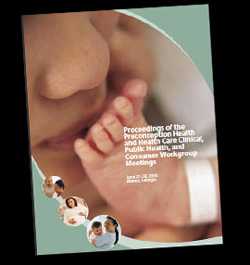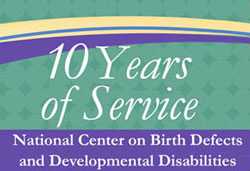1946

- The Communicable Disease Center (CDC) is established in Atlanta (the precursor of the current Centers for Disease Control and Prevention). CDC’s goal is to protect the public by quickly identifying diseases brought into the United States by soldiers returning from out of the country.
1961

- CDC expands its reach into chronic disease with investigation of a cancer cluster in Niles, Illinois. Because of the connection between cancer and birth defects, CDC begins to explore birth defects research issues.
1967

- After the thalidomide tragedy in Europe, the Metropolitan Atlanta Congenital Defects Program (MACDP)–the first population-based birth defects surveillance system in the United States―is born.
1984

- CDC confirms that the acne medication isotretinoin (Accutane®) is linked with serious birth defects.
- CDC and the Georgia Department of Human Resources initiate the Metropolitan Atlanta Developmental Disabilities Study (MADDS) to provide population-based prevalence data on developmental disabilities.
1987

- A disabilities prevention program is created within the CDC’s National Center for Environmental Health.
1989

- CDC publishes a report that identifies birth defects as a leading cause of infant mortality. This report also notes that heart defects account for 38% of birth defects-related infant mortality.
1991

- CDC launches the Metropolitan Atlanta Developmental Disabilities Surveillance Program (MADDSP), an ongoing, population-based prevalence study of four developmental disabilities.
- CDC issues a recommendation that women who have had a pregnancy affected by a neural tube defect (NTD) consume 4 milligrams of the B-vitamin folic acid daily, prior to pregnancy, for preventing the recurrence of NTDs.
- CDC establishes the Fetal Alcohol Syndrome Unit in the Division of Birth Defects and Developmental Disabilities at the National Center for Environmental Health.
1994

- CDC launches a six-state surveillance project to identify everyone in those states with hemophilia. The project collects important data on care and outcomes for people with hemophilia and provides the first population-based estimates of the burden of this bleeding disorder.
- CDC appropriates funding to establish at the state-level Centers for Birth Defects Research and Prevention (CBDRP).
1996

- A group of individuals involved in birth defects surveillance meets and begins to develop the National Birth Defects Prevention Network (NBDPN), an incorporated organization with participants from all 50 states.
1997

- CDC begins Early Hearing Detection and Intervention activities as part of a national effort to promote the early detection of hearing loss, tracking of infants and children who have hearing loss, and initiation of effective intervention systems.
- CDC and the National Birth Defects Prevention Network (NBDPN) publish the first annual Congenital Malformations Surveillance Report. This is the first time population-based birth defects surveillance data from a number of states presented together.
- CDC partners with three universities to develop and test Project CHOICES (Children Have Opportunities in Inclusive Community Environments and Schools), a motivational intervention aimed at preventing alcohol-exposed pregnancies. Study results show that a brief motivational intervention can reduce the risk of an alcohol-exposed pregnancy. Project CHOICES becomes a model program embraced by researchers and used in other federal initiatives.
- The Fetal Alcohol Syndrome Surveillance Network is created to determine the prevalence of fetal alcohol syndrome within certain regions of the U.S.
- A CDC-funded study concludes that screening newborns to identify children with sickle cell disease reduces early childhood mortality from the disease to very low levels.
1998

- CDC initiates one of the few programs in the world that conducts active, ongoing monitoring of the prevalence of autism spectrum disorder among children.
- NCBDDD initiates Legacy for Children™, a set of longitudinal, randomized, controlled studies examining the potential for improving child developmental outcomes through parenting programs designed to promote self-efficacy and a sense of community.
- CDC begins collaborating with approximately 140 hemophilia treatment centers through the Universal Data Collection (UDC) Program to monitor blood product safety and outcomes of care for people with bleeding disorders.
- CDC, the March of Dimes, and the NCFA launch the National Folic Acid Campaign to promote the use of folic acid to prevent birth defects.
1999

- CDC publishes the first study to show that 400 micrograms of folic acid alone (rather than included with other multivitamins) taken before and during early pregnancy can achieve dramatic reductions in the rates of these serious birth defects of the spine and brain.
- Congress directs CDC to study hereditary hemochromatosis and other iron-related disorders.
- The Children’s Health Act of 2000 is passed by Congress and signed into law by President William J. Clinton. It requires the establishment of the National Center on Birth Defects and Developmental Disabilities (NCBDDD) at CDC by April 15, 2001. As specified in the act, the new center will include what heretofore were the programs, functions, and staff of the Division of Birth Defects and Developmental Disabilities, National Center for Environmental Health.
2000

- The National Center on Birth Defects and Developmental Disabilities (NCBDDD) is established.
- Dr. Jose Cordero is named director of NCBDDD.
- CDC organizes the Autism and Developmental Disabilities Monitoring (ADDM) Network, a surveillance program to collect data for determining prevalence of autism spectrum disorders and other developmental disabilities at multiple sites across the U.S.
- CDC establishes the Centers for Autism and Developmental Disabilities Research and Epidemiology (CADDRE) Network.
2001

- NCBDDD publishes the first evaluation showing that folic acid fortification has reduced the prevalence of neural tube defects in the U.S.
- Congress authorizes NCBDDD to develop public health programs related to muscular dystrophy under the Muscular Dystrophy Community Assistance, Research and Education Amendments of 2001 (also known as the MD-CARE Act).
- Congress mandates that issues related to children’s neurobehavioral disorders, including ADHD, be included as part of NCBDDD’s research agenda. Tourette syndrome is added to this group of disorders in 2004.
2002

- NCBDDD releases its first multi-state, population-based report on the prevalence estimate of fetal alcohol syndrome.
- NCBDDD and the FDA carry out two investigations to learn more about a possible association between cochlear implants and bacterial meningitis among children with cochlear implants. The study finds that children with an implant are 30 times more likely to get a type of bacterial meningitis than are children of the same age among the general population. The studies also find that children with an implant with a positioner (used with some implant models) are more likely to get meningitis than children who have an implant without the positioner. The implant model with a positioner voluntarily is removed from the market by the manufacturer in July 2002. Vaccination recommendations are changed to include cochlear implant recipients in the high-risk group for bacterial meningitis.
- The Division of Blood Disorders joins NCBDDD.
2003

- NCBDDD issues the AUTISM A.L.A.R.M. with the American Academy of Pediatrics, summarizing the recent prevalence studies done that confirm that more children with autism spectrum disorder are being identified than in the past.
- The “Learn the Signs. Act Early.” campaign is launched to raise awareness of the signs of autism and other developmental disabilities.
2004

- Congress directs NCBDDD to initiate a Diamond Blackfan anemia program.
2005

- NCBDDD and its partners release a set of 10 recommendations for preconception health and convene the first national preconception conference.
2006

- Dr. Edwin Trevathan is named director of NCBDDD.
- The Autism and Developmental Disabilities Monitoring Network issues its first reports, indicating an average of 1 in 150 children are affected by autism spectrum disorder.
2007

- The Study to Explore Early Development (SEED) is implemented, one of the largest studies of its kind in the U.S. to help identify factors that might put children at risk for autism spectrum disorder and other developmental disabilities.
- Based on the results of an NCBDDD-sponsored clinical trial, prophylactic (preventative) treatment becomes the standard of care in the U.S. for people with hemophilia.
- NCBDDD establishes the Thrombosis and Hemostasis Centers Research and Prevention Network to provide an opportunity for broad, population-based research on deep vein thrombosis and pulmonary embolism.
2010

- NCBDDD works with many state and local health departments to investigate pandemic flu among pregnant women, children, and people with disabilities. This work leads to swift action to develop guidance and recommendations for these vulnerable populations.
- The Duchenne muscular dystrophy (DMD) Care Considerations guide is published.
- NCBDDD and the National Heart Lung and Blood Institute establish a pilot surveillance system for sickle cell disease and thalassemia called the Registry and Surveillance for Hemoglobinopathies (RuSH).
2011

- Dr. Coleen A. Boyle is named director of NCBDDD.
2012

- NCBDDD conducted the first study to look at the costs and health outcomes (cost-effectiveness) of newborn screening for early identification of children with a critical congenital heart defect (CCHD).
2013

- NCBDDD launches Birth Defects COUNT, a global initiative to reduce death and disability due to neural tube defects.
- The Birth Defects Study To Evaluate Pregnancy exposureS (BD-STEPS) is announced. This study further examines findings from the National Birth Defects Prevention Study and follows up on leads to understand more about what causes birth defects and how to prevent them.
2014
- NCBDDD’s Autism and Developmental Disabilities Monitoring Network finds an average of 1 in 68 children are affected by autism spectrum disorder.
- Launched a nationwide report on adults with disabilities and physical activity. CDC’s Vital Signs™ : “Adults with Disabilities – Physical Activity is for Everybody” presented data showing that 1 in 2 adults with a disability get no aerobic physical activity and that people with disabilities who had a recommendation from a doctor or health professional were more likely to be physically active.
2015
- Closed the gap in the early identification of deaf and hard of hearing infants by launching EHDI-DASH (Early Hearing Detection & Intervention Data Analysis and Statistical Hub), an interactive dashboard that presents a range of data about the early identification of deaf and hard of hearing infants across the United States.
2016
- CDC published evidence concluding that Zika virus infection during pregnancy is a cause of microcephaly (small head and brain) and other severe fetal brain defects. CDC and partners developed and implemented a multifaceted communication campaign called “This is How We Stop Zika.” This campaign was aimed at educating pregnant women and communities in U.S. territories about Zika prevention.
- Provided new data on alcohol use during pregnancy, which estimated more than 3 million U.S. women are at risk for an alcohol-exposed pregnancy.
- Page last reviewed: February 23, 2016
- Page last updated: February 23, 2016
- Content source:
TOP
Error processing SSI file



























 ShareCompartir
ShareCompartir